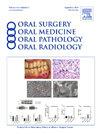Detection of mandibular molar furcation involvement on intraoral radiograph by machine learning
IF 2
3区 医学
Q2 DENTISTRY, ORAL SURGERY & MEDICINE
Oral Surgery Oral Medicine Oral Pathology Oral Radiology
Pub Date : 2025-02-04
DOI:10.1016/j.oooo.2024.11.036
引用次数: 0
Abstract
Objective
Artificial intelligence (AI) is speculated to help accomplish sophisticated human tasks owing to its rapid development. Radiology is at the forefront of health care specialties that are readily accessible by AI. There are studies investigating the accuracy of AI in diagnosis of dentoalveolar pathoses. However, not much is known if AI is able to detect molar furcation involvement (FI), a condition that may have limited clinic accessibility. The objective of the study is to evaluate the detection of mandibular molar FI on intraoral radiograph by machine learning.
Study Design
The school's Axium was screened and patients with or without mandibular molar FI were enrolled. Mandibular molar periapical radiographs were cropped into single tooth images and annotated manually as healthy or FI. The images were divided as training, validation and test sets. Multiple machine learning models were trained to identify FI. Images were fed into these classifiers and their diagnostic accuracy for molar FI was evaluated.
Results
Preliminary, 55 healthy and 66 FI molars were evaluated. Twelve classifiers were modified and tested, which included neural net, RBF, SVM, Adaboost, QDA, decision tree, random forest, nearest neighbors, logistic regression, Gaussian process, linear SVM, and naive Bayes. They demonstrated accuracy in the range of 45% to 60%, with random forest performing the best with 60% accuracy.
Conclusion
Machine learning seems to be a promising tool in detection of mandibular molar FI on intraoral radiograph. Larger sample size is needed to further improve the diagnostic performance of the algorithms.
求助全文
约1分钟内获得全文
求助全文
来源期刊

Oral Surgery Oral Medicine Oral Pathology Oral Radiology
DENTISTRY, ORAL SURGERY & MEDICINE-
CiteScore
3.80
自引率
6.90%
发文量
1217
审稿时长
2-4 weeks
期刊介绍:
Oral Surgery, Oral Medicine, Oral Pathology and Oral Radiology is required reading for anyone in the fields of oral surgery, oral medicine, oral pathology, oral radiology or advanced general practice dentistry. It is the only major dental journal that provides a practical and complete overview of the medical and surgical techniques of dental practice in four areas. Topics covered include such current issues as dental implants, treatment of HIV-infected patients, and evaluation and treatment of TMJ disorders. The official publication for nine societies, the Journal is recommended for initial purchase in the Brandon Hill study, Selected List of Books and Journals for the Small Medical Library.
 求助内容:
求助内容: 应助结果提醒方式:
应助结果提醒方式:


